A Shiloh Sharps has been on my wish list for quite a few years, so I definitely was looking forward to seeing their booth at SHOT Show. Not having much, er, any experience with these types of rifles, I was impressed with their weight. Barrel length and diameter is also impressive, as was the many options for front pinhead sights and rear tang sights with Hadley eyedisks. More Pics after the jump:
The hand engraving was truly a work of art:
Upgraded woods are also available:
Prices start at $1900 or so, but can reach north of 6K once they are hand engraved, case colored, and other options are added.
Other models are also available:

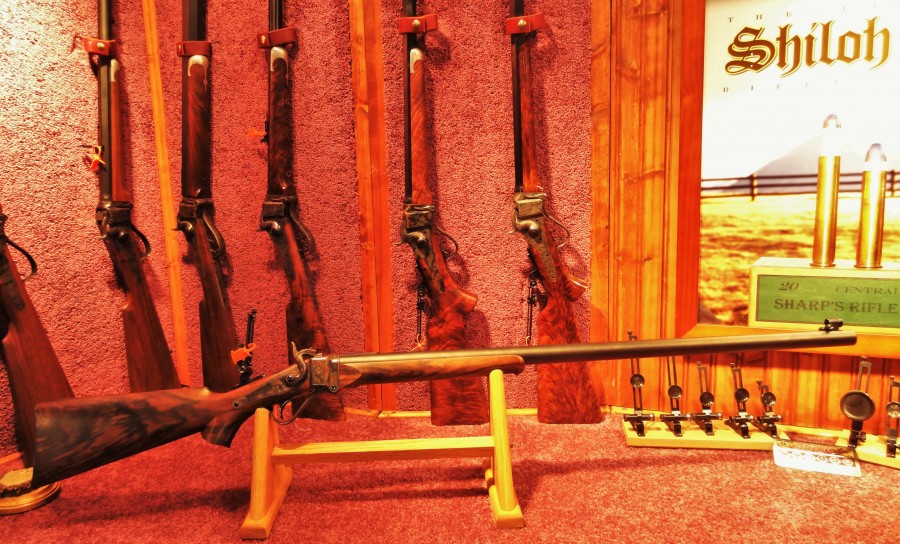
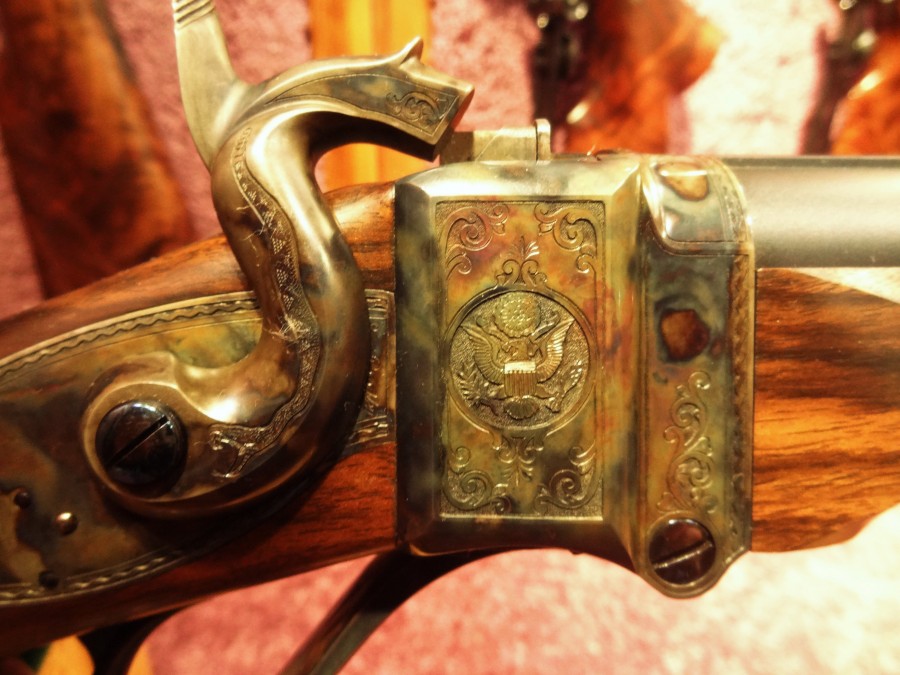
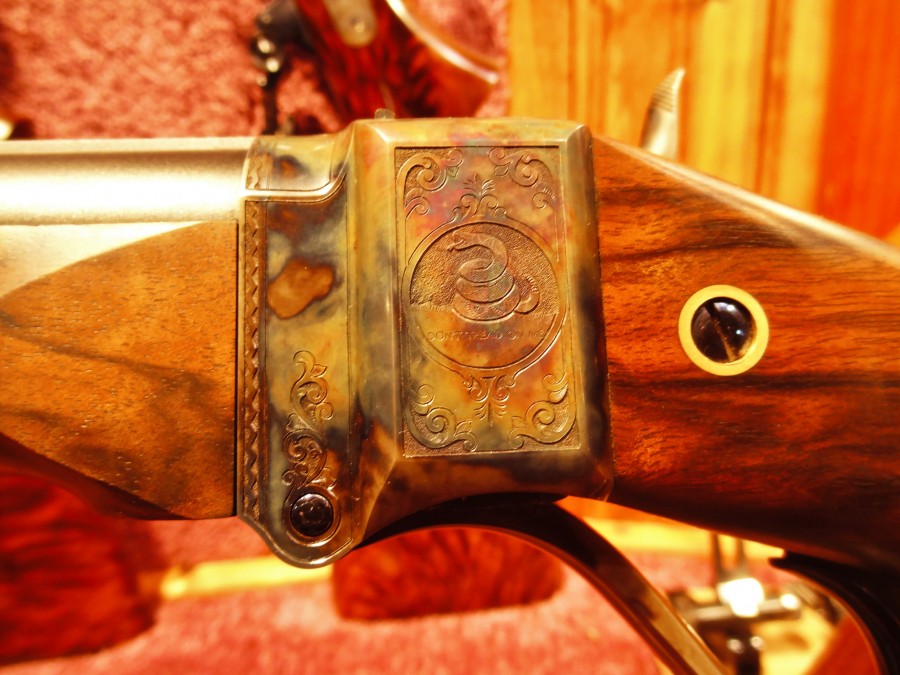

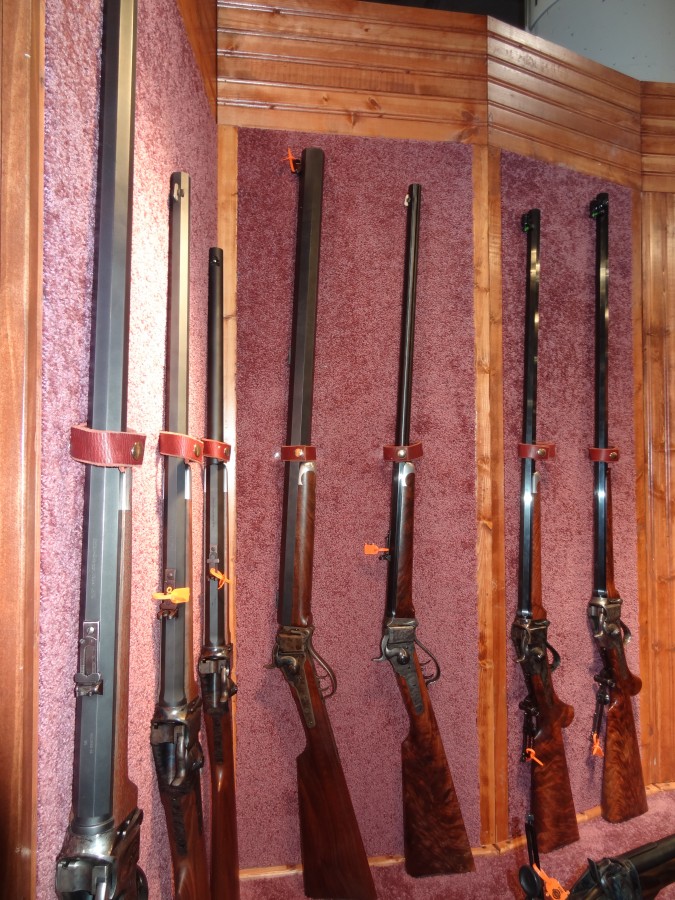
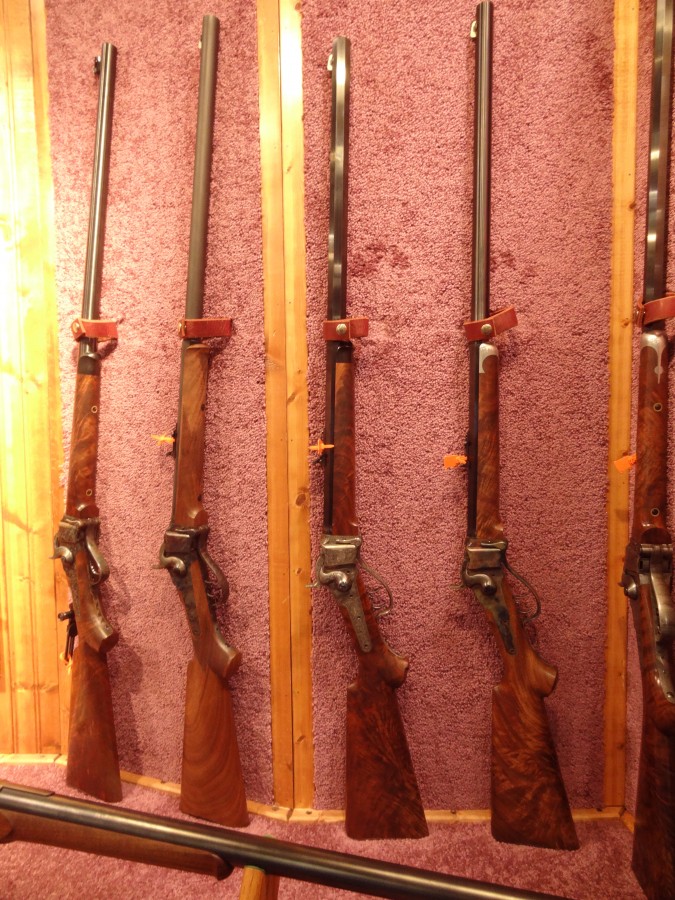
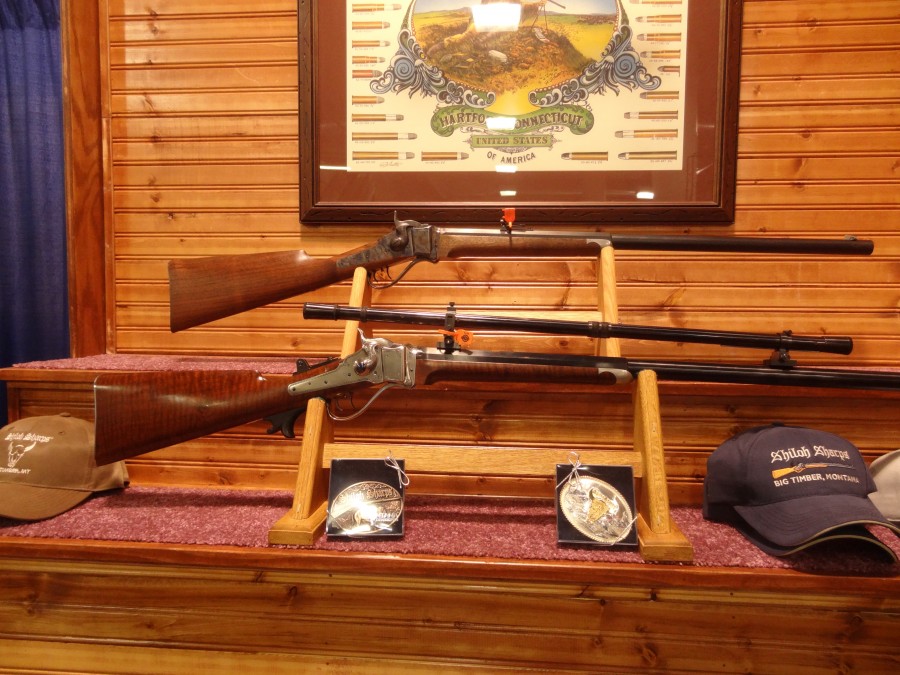



Want one. Now.
You’re killing me…
Wow. Beautiful.
Just went to the Shiloh website and the Quigley theme music started playing. How kewl is that.
Zulu gave me a life long lust for Martini’s, never satisfied. Quigley did the same for Sharps. SIGH.
That need for a Sharps was made it even worse
when Shiloh started making the Quigley model.
Wow.
Clicking on those high-res photos is stunning.
These beat the socks off my Remington rolling block.
They shoot too, so much more than just a pretty face. And pretty they certainly are!! I had 11 months to save for mine once ordered. And you’ll never groan about the price of tritium handgun sights again after shelling out nearly $600 for long range vernier and globe sights!!
I’d love to have one of the military model Sharps with the forearm nearly to the end of the barrel. I just think they look entirely cool.
i’d hope they weigh a bunch firing 45-70 or larger.
It’s a lever-action, breach-loader. Usual barrel length’s thirty inches. This one has an extra four. It’s converted to use a special forty-five caliber, hundred-and-ten-grain metal cartridge, with a five-hundred-forty-grain paper patch bullet. It’s fitted with double-set triggers, and a Vernier sight, marked up to twelve-hundred yards. This one shoots a mite further.
SO want one. It doesn’t even have to be fancy engraved with the gorgeous wood.
Yes. WANT.
Quigley made me.
That scene where the only sound is the *smack* of bullets hitting the bad guys and then three seconds later, as the survivors scatter, the sound of the gunshot finally rolls in… One of my favorite movie moments and one of several favorite moments from that movie.
That is a thing of beauty.
I hate you Joe Grine. Reminding me of something I so so want but cannot afford.
Well, if it makes you feel any better, I really can’t afford a 6K rifle either.
Where does the 1913 rail mount to? How can it be a rifle without rails? I kid, I kid!
Like everyone else, I’ve wanted a Sharpes rifle ever since Quigley Down Under. It’s a beautifully elegant rifle.
Good taste sir. I’ve had some older guys let me shoot their Sharps rifles at ranges. Ringing steel with big ‘ole slow moving lead bullets at long range is an experience that gets into your blood. Then there is the obligatory motion of dropping the breach, ejecting the cartridge, the blowing down the barrel (from the breech end) just like Quigley.
So Cool!
Oh, wow!
Amazing! I haven’t seen Quigley in a long time, but I might have to watch it again this weekend.
When you finish watching “Quigley Down under”, check out the Burt Lancaster film, “Valdez is coming”. It’s another good film showcasing some long range shooting with a Sharps rifle.
I read a ballistics report done way back in the ’80s–1880s–about the 45-70 cartridge using special barrels. I many be mistake, but I seem to recall that by placing the rifle at a 27 degree slopw, hey could toss a bullet something north of 3000 yards.
yeah I was right. Sandy Hook testing grounds. Per Wikipedia::
“After the Sandy Hook tests of 1879, a new variation of the .45-70 cartridge was produced: the .45-70-500, which fired a heavier 500 grain (32.5 g) bullet. The heavier 500-grain (32 g) bullet produced significantly superior ballistics, and could reach ranges of 3,350 yards (3,120 m), which were beyond the maximum range of the .45-70-405. While the effective range of the .45-70 on individual targets was limited to about 1,000 yards (915 m) with either load, the heavier bullet would produce lethal injuries at 3,500 yards (3,200 m). At those ranges, the bullets struck point-first at a roughly 30 degree angle, penetrating 3 one inch (2.5 cm) thick oak boards, and then traveling to a depth of 8 inches (20 cm) into the sand of the Sandy Hook beach*. It was hoped the longer range of the .45-70-500 would allow effective volley fire at ranges beyond those normally expected of infantry fire.”
Try that with M855 or XM193 ammo out of a poodle-shooter. 😉
This is why I like to tell people: “Velocity disappears all the way downrange. Mass doesn’t.” when they question why I like heavy, slower-moving bullets.
Yup. think “freight train”. Slow, but real hard to stop.
Now that is some interesting historical reading! Thanks for sharing that with us, I always like to learn more about ballistics, especially from older cartridges.
Joe, thank you for your efforts there at the SHOT show. I was getting to a point where I was going to ignore TTAG for a couple weeks as the black phosphate and cheez-whiz boys had their way.
The other thing I like about your pieces is that you take high resolution photos, which allow me to actually see important details. eg, your shots on the Mauser ’03 rifle are of a high enough resolution to allow me to see the open pores in the grain on the wood.
As for the weight of these rifles: Having fired a few of them with 535 grain pills on a .45-70 or .45-90, I can tell you this: You’d cringe to think of them being any lighter. They rock your world when you’re shooting them off a bench.
I like a 525 grain lead pill pushed by black powder a whole lot better that a 350 JHP with smokeless!!
It is unnerving using BP for the first time in a rifle this expensive.
I love the wood on these….holy crap.
Uh….am I the only one who hasn’t seen Quigley down under?
Yes. But that’s an oversight you can correct.
I have a 50-110 express model 86 deluxe Winchester lever and I’ve always wanted a Shloh 77 large caliber rifle as they are a real rifle and very historic!
Check out the following info for BPCR (black powder cartridge rifle): http://www.BPCR.net, http://www.longrangeBPCR.com. And the American Single Shot Rifle Association (www.assra.com).
Having shot a fair number of these goodies ranging from .38-55 through .50-140, I have a few recommendations for someone buying their first one. If you want a light weight one for hunting, don’t get anything bigger than .45-70 unless you plan on shooting it only a few times a year. The big .50s use a 700-gr lead bullet, and it will thump you. The .45-70 uses a 405 to 520 grain bullet, and it will take care of any large North American game animal. If you are getting into the BPCR silhouette game, the .40-65 seems to be the best combination of effectiveness on the 500-yd rams with tolerable recoil. The .38-55 had a brief popularity for a while, but the bullets are too light to guarantee knocking down the 65-lb ram silhouettes. The 500+ gr bullet from the .45-70 will take down the ram no matter where you hit it, and the ammo/cases are a bit easier to find. (You will need to get into reloading if you go with black powder loads.) .40-65 cases can be formed from .45-70 brass.
Reloading with black powder, and cleaning the resultant residue (VERY hygroscopic -“readily taking up and retaining moisture” = rust city), is a whole ‘nother topic that the BPCR folks will be happy to help with. Including why you need to use a “drop tube” when you make black powder loads.
Warning: the BPCR hobby can easily become an obsession, if you haven’t noticed.
When I get to a point where I’m working on only my guns and my wife’s list of things for me to do finally runs out (fat chance), BPCR is where I’m going. Oddly enough, I know several other gunsmiths who, after a long term of messing about with various guns for other people, gravitate towards BPCR.
What I think many people don’t understand about BPCR guns is how accurate they can be, or how utterly satisfying it is to light one of these beasts off.
One of the reasons one of my buddies told me he shoots BPCR’s now is this: His wife prevailed upon him to trim his collection down, seeing how they’re in their 80’s. She didn’t want to have to deal with a large collection to disperse when he passes on.
He thought she was seeking to force him to spend “less time on guns and more time with her.”
With a single 1874 in .45-90, he says he can spend all the time he has on one gun, quite successfully. The honey-do list was thwarted yet again…
IdahoPete, I’d add that at least where Shiloh is concerned, they would (or did) only recommend or warranty rifles chambered in .38-55, .30-40 Krag, and .45-70 with smokeless powder. So for someone not sure they are ready to commit to black powder, these are the recommended chamberings and also those that are available over the counter in the “white powder”. I was in the same boat, and had also read some of Mike Venturino’s writings on the subject, and per his recommendations (and cool factor of course) I chose .45-70.
Another great resource is the Shiloh rifle forum:
http://www.shilohrifle.com/forums/
Lots of fun, great people, and a more relaxed pace.
I live fairly close to Big Timber, MT and I worked in the Big Timber area a couple years ago. Went to both Shiloh and C. Sharps shops. Asked about getting a Sharps 45-70 and 45-110 built. The backlog was about 2 years at the time. Yep, I still have it on my “wish list” as well. I need to take the time and learn what I can about the firearm and making custom loads.
Love my Shiloh 1874 Sharps. If you get your blackpowder handloading skills to the point of producing consistent ammo, they are amazingly accurate. I still need work on both the loading and the Vernier sight marksmanship, but what a “blast” shooting this great rifle.
Hey guys. I’ve been shooting a Pedersoli 1874 Sharps – the Long Range model – for about 14 years now. It’s chambered 45-70. Been shooting BPCR about that long too. Took about 2 years to get a really consistent accurate load – there’s a lot to learn. But the folks in BPCR are some of the best, and always willing to assist and share knowledge. The comments above are correct – these guns are superbly accurate once you figure out the loading process. I even got the wife into it. Her gun is a Pedersoli long range rolling block, also 45-70. She beat my score for the first time two months ago – I may never live that down. I also have shot a few disciplines, but have stuck with BPCR. There really is something to settling in those sights on those tiny targets, then touching off that big gun, seeing the flame and smoke, and hearing that lovely sound, and watching the steel go down. Some of the guys I shoot with have the Shilohs – sometimes I beat them, sometimes not, but we have a blast. Would love a Shiloh, but until the two girls are clear of college, my Pedersoli’s are plenty good enough! Just got a rolling block in 40-65 – getting ready to start working up loads – sights are coming. Here we go again!
I have a Shiloh Business in 45-70 with the MVA long range tang passed to me by my Uncle ( now in his 80’s). What are they like to shoot? The best analogy I can come up with is the Naval Big Guns. If you think you would have a mile-wide grin after lighting off a 16 inch battleship round..with the silk bags,swirling smoke and flame; then this gun ,shooting a 500 grain cast bullet, is something to consider. Point Oscar is still there and I can hear the command “batteries release” !
I would also add if you want it as a smokeless hunting gun….check out the Accurate 5744 powder.
Excellent news for iPhone and Ipad people! Do u are looking for Power Rangers in just your hand?. You’ve seen heroes many times on TV, now It’s the chance to think&guessing them
kamen rider drive krim steinbelt http://apple.co/293e5r0
Comments are closed.